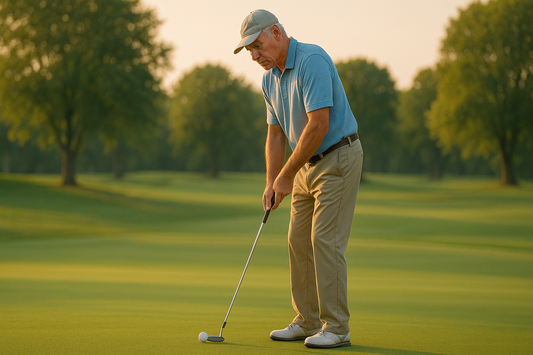I spend most of my time coaching competitive junior golfers, but some of the most rewarding work I've done has been helping older players, especially my 74-year-old father rediscover their putting stroke. These guys often putt better now than they did in their forties. Not because they've gotten stronger or their eyesight has improved, quite the opposite, in fact. They've gotten better because they've learned to work with their limitations instead of fighting them.

Last year, my dad came to me frustrated because his putting had gone to hell. He'd been a single-digit handicapper, but now three-putted greens he used to attack with confidence. "I can't see the lines like I used to," he told me, "and my hands shake on the short ones."
Here's what I told him: Your stroke doesn't have to get worse with age. It just has to get different.
The Body Changes, the Mind Adapts
Let's be honest about what happens as we age. Your vision changes—depth perception and contrast sensitivity decline. Those subtle breaks that used to jump out now blend into the green. Your hands aren't as steady, especially under pressure. Your back might not let you hold that bent-over stance for thirty years.
But some of the best putters I've worked with are seniors who've learned to adapt their technique to work with their changing bodies instead of against them. The key is identifying your specific challenges and adapting accordingly, rather than trying to maintain a putting style that worked when your body was different.
Equipment That Actually Helps

That trusty blade putter from the Clinton administration might be working against you now. Senior golfers often benefit from equipment changes that younger players would never consider. Sometimes find a new putter to match your changing stroke can make all the difference.
Longer putters aren't just for bad backs, they help with stability and reduce fine motor control needed in your hands. I've seen players like my dad go from shaky three-footers to rock-solid short putting by switching to a 38-inch putter that let them stand upright.
High-contrast alignment aids become crucial when your eyes can't pick up subtle visual cues. Some manufacturers now make putters specifically for seniors, with larger, more visible alignment features.
Oversized grips can improve your stroke by reducing unwanted hand action—something that benefits seniors more than younger players. They also reduce pressure points that cause discomfort during longer rounds.
Heavier putterheads help create momentum that carries through the stroke even when your hands aren't steady. Face-balanced putters often work better for seniors who've developed a straight-back, straight-through stroke.
Reading Greens When Your Eyes Fail You

This is where experience becomes your secret weapon. While your eyes might not pick up subtle slopes, you've read thousands of greens. That pattern recognition doesn't disappear, but you just need to access it differently.
Walk the putt and feel the slope through your legs. Use green-reading apps that show slope and break. These are tools that help you function at your best, just like reading glasses.
Take more time reading greens from multiple angles. When your eyes need more information to process slope and break, give them that time. Trust your experience over immediate visual perception.
Embrace the Rhythm Revolution

Many senior golfers actually develop better tempo as they age. When you can't rely on hand-eye coordination, you're forced to develop a more rhythmic, pendulum-like stroke.
Embrace a longer, more flowing stroke instead of fighting for the short, controlled stroke you used when your hands were steadier. Let the putter swing rather than trying to guide it. Practice with a metronome set to a comfortable tempo—often slower than younger golfers use.
The Mental Game Gets Stronger
Senior golfers often develop the best putting psychology, I've seen. They've played enough golf to know that three-putting happens, and they're not trying to impress anyone with aggressive putts.
This mental maturity translates to better course management. They lag long putts to the center instead of trying to make everything. They take the safe side of breaking putts. They understand that two-putting from forty feet is victory, not failure.
Distance Control: Your Secret Weapon
Senior golfers often excel at distance control because years of experience have taught them how putts roll on different greens. Focus on this strength while adapting to physical changes.
Practice distance control more than line. If you consistently get your first putt within three feet, your putting statistics will improve dramatically even if you don't make more long putts.
Practice Strategies That Work

Short, frequent practice sessions work better than marathon putting sessions. Fifteen minutes of focused practice several times a week beats one long session that leaves you tired.
Focus on fundamentals one at a time: alignment one day, tempo the next, distance control after that. Use distance control drills rather than trying to make everything.
The Bottom Line
Adapting your putting as you age is about continuing to improve at the game you love in different ways. The goal isn't to putt like you did thirty years ago. The goal is to putt as well as possible with the body and mind you have today.
Start with an honest assessment of what's changed. Practice with purpose, focusing on distance control over making putts. Develop consistent routines. Embrace technology and equipment that helps you play better.
Most importantly, remember that putting isn't about age, it's about adaptation. Your putting stroke can get better with age, but only if you're willing to let it evolve. Different doesn't mean worse. Whether it's helping my dad or other senior golfers I've worked with, I've seen how adapting technique and equipment can lead to better putting and more enjoyment on the greens than they've had in years.





